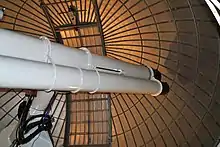UCL Observatory
UCL Observatory (called the University of London Observatory until 2015[1][2]) at Mill Hill in London is an astronomical teaching observatory. It is part of the Department of Physics and Astronomy at University College London.
 The observatory in March 2009 | |
| Alternative names | University of London Observatory |
|---|---|
| Observatory code | 998 |
| Location | London Borough of Barnet, Greater London, London, England |
| Coordinates | 51°36′48″N 0°14′31″W |
| Website | www |
 Location of UCL Observatory | |
History
The Observatory was opened, as the University of London Observatory, on 8 October 1929 by the then Astronomer Royal Frank Watson Dyson, initially to house the 24-inch reflector built by Grubb of Dublin in 1881 and housed in Dr W.E. Wilson's observatory at Daramona, County Westmeath, Ireland, which was donated to the University of London after his death.
An 8-inch refractor was installed in 1931 following its donation to the University by H.R. Fry of Barnett the previous year. In July 1938, the Observatory was further expanded to accommodate the 24-inch/18-inch twin refractor that had been removed from the Radcliffe Observatory at Oxford in 1934.
In 1951, UCL took over management of the Observatory from the University of London, and over the next ten years added library, lecture, and laboratory space. (The administrative handover was recognised in a formal renaming from the University of London Observatory to UCL Observatory in October 2015.)
The Wilson telescope was retired in 1974 (to the Merseyside Museums), and was replaced the following year with a new 24-inch Ritchey-Chrétien Cassegrain reflector which was named after the former director of the Observatory, Professor C.W. Allen.
Current Status
In addition to the Fry, Radcliffe, and Allen telescopes, two Celestron 14-inch Schmidt-Cassegrain telescopes are housed in permanent domes, and there are several smaller free-standing telescopes.
After 13 years of fund-raising efforts, a new ASTELCO 80 cm Ritchey–Chrétien telescope is planned to be install on site in the Summer of 2018.[3] This will replace the Allen telescope, and become the facility's biggest telescope.
The observatory's primary purpose is to provide UCL undergraduates with training in practical astrophysical techniques and data-handling. There is also a research programme, involving students in observing transits of extrasolar planets.
SN2014J
On 21 January 2014 supernova SN2014J was discovered at the observatory by astronomer Steve Fossey during a session with four undergraduate students.
Gallery
.jpg.webp) The Radcliffe twin refractor telescope
The Radcliffe twin refractor telescope Telescope enclosures at the observatory
Telescope enclosures at the observatory One of two Celestron C14 reflector telescopes at ULO
One of two Celestron C14 reflector telescopes at ULO Fry refractor telescope, the observatory's oldest telescope
Fry refractor telescope, the observatory's oldest telescope Despite its modest diameter, the Radcliffe telescope is very long because it has a long focal length
Despite its modest diameter, the Radcliffe telescope is very long because it has a long focal length
References
- "About the University of London Observatory". University College London. Retrieved 11 April 2016.
- "UCLO history: timeline". University College London. Retrieved 11 April 2016.
- http://www.ulo.ucl.ac.uk/dev-project/
